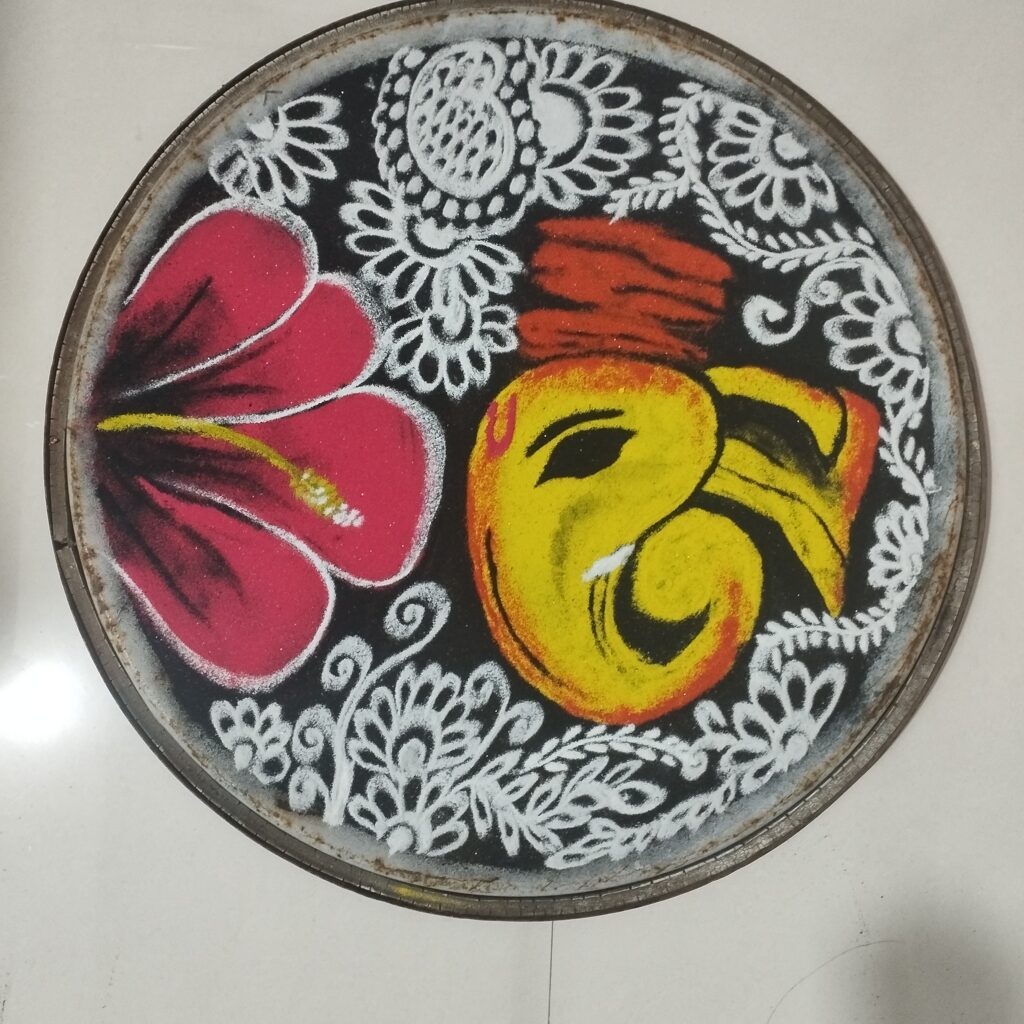Ganesha rangoli simple and easy

In this article, you will learn how to draw simple and easy Ganesha rangoli for any occasion.

Creating a Divine Connection: Drawing Ganesha Rangoli and Exploring its Significance
Rangoli, an ancient and vibrant art form, holds a special place in Hindu culture. Among the myriad designs that grace doorsteps during festivals and auspicious occasions, the Ganesha Rangoli stands out with its intricate patterns and divine symbolism. In this article, we delve into the art of drawing Ganesha Rangoli, explore the significance of Lord Ganesha in Hindu religion, and understand the importance of divine rangoli in connecting with the spiritual realm.
The Art of Drawing Ganesha Rangoli
1. Materials Needed:
- Colored rangoli powders
- Fine-tipped rangoli cones or small containers for powder application
- Design template or reference image
2. Choosing a Design:
- Ganesha Rangoli designs vary, from simple outlines to intricate patterns. Select a design based on your skill level and the occasion.
3. Preparing the Surface:
- Clean the area where you plan to draw the rangoli. This ensures a smooth canvas for your artwork.

4. Drawing the Outline:
- Begin by sketching the basic outline of Lord Ganesha using a chalk or light-colored rangoli powder. This serves as a guide for the intricate details.
5. Filling Colors:
- Use vibrant colored powders to fill in different sections of the design. Take your time to create a visually appealing and balanced composition.
6. Adding Details:
- Enhance the beauty of your Ganesha Rangoli by adding details like flowers, paisley patterns, or geometric shapes around the deity.
7. Completing the Design:
- Once satisfied with your creation, carefully remove the chalk or light-colored powder outlines, leaving behind a stunning Ganesha Rangoli.
Significance of Lord Ganesha in Hindu Religion
Lord Ganesha, revered as the remover of obstacles and the god of wisdom, holds a prominent place in Hindu mythology. His distinctive elephant head and portly figure symbolize intellect, knowledge, and prosperity. Devotees often seek Ganesha’s blessings before embarking on new ventures or important life events.
1. Obstacle Removal:
- Ganesha is worshipped at the beginning of any task to seek his divine intervention in removing obstacles and ensuring a smooth path ahead.
2. Intellect and Wisdom:
- As the patron of arts and sciences, Ganesha is revered for bestowing intellect, wisdom, and creativity upon his devotees.
3. Symbol of Prosperity:
- The presence of Ganesha in homes is believed to attract prosperity and good fortune. Many households have a dedicated space for Ganesha idols or pictures.
4. Festivals Dedicated to Ganesha:
- Ganesh Chaturthi, one of the most celebrated festivals in Hinduism, involves elaborate rituals and festivities dedicated to Lord Ganesha.
Importance of Divine Rangoli
Rangoli, a traditional art form that originated in India, is not just about creating visually appealing patterns; it holds deep spiritual significance. The act of drawing rangoli is considered auspicious, and various designs are chosen based on the occasion and deity.
1. Spiritual Connection:
- Drawing rangoli is seen as a spiritual practice that connects individuals with higher realms. The geometric precision and symmetry in rangoli patterns are believed to invoke positive energies.
2. Symbolic Meanings:
- Different elements in rangoli designs carry symbolic meanings. Flowers represent beauty, while geometric patterns symbolize order and balance. Incorporating these into a Ganesha Rangoli enhances its spiritual significance.
3. Ritualistic Importance:
- Rangoli is often drawn during religious ceremonies and festivals. It is believed to welcome deities and bring auspiciousness to the surroundings.
4. Community Bonding:
- Drawing rangoli is a communal activity during festivals, fostering a sense of unity and togetherness. It becomes a shared expression of culture and tradition.
Drawing a Ganesha Rangoli goes beyond artistic expression; it becomes a spiritual journey, connecting the artist with the divine. The intricate patterns and vibrant colors symbolize not only the beauty of art but also the rich tapestry of Hindu culture and religious beliefs. As we explore the significance of Lord Ganesha and the importance of divine rangoli, it becomes clear that these traditions are not just rituals but powerful means of fostering a deeper connection with the spiritual realm. So, the next time you draw a Ganesha Rangoli, remember that you are not just creating art; you are invoking the blessings of wisdom, prosperity, and divine grace into your home.
